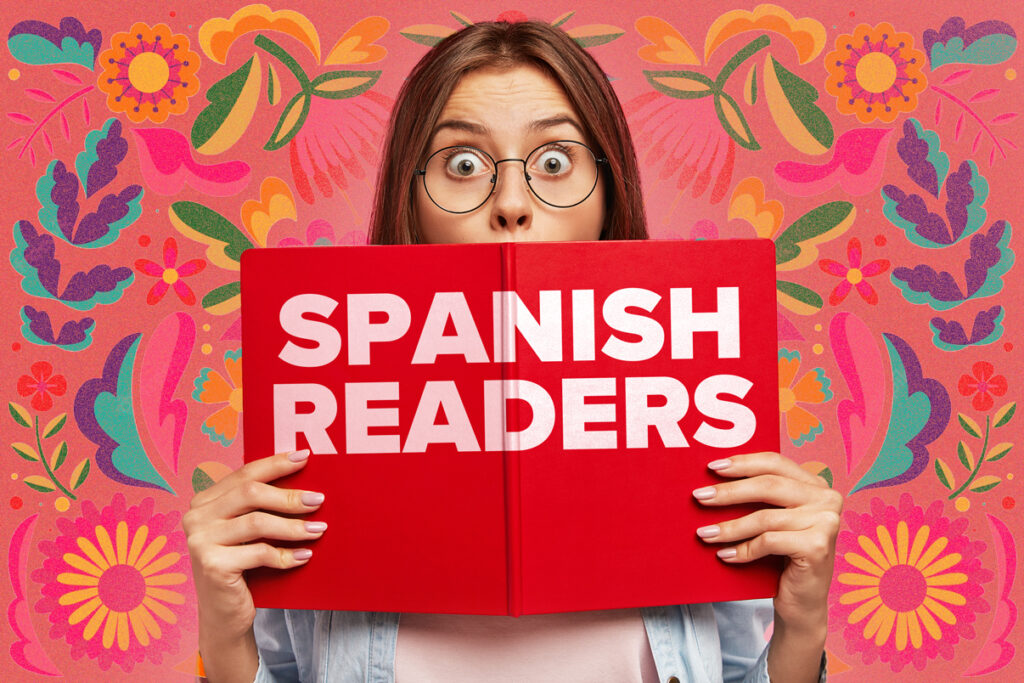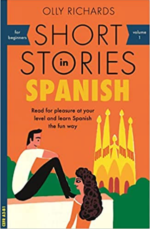
10 Spanish Readers to Add to Your Library Right Now
Reading is a vital part of any language.
If you travel, you’ll need to read a map in the subway. And when you’re at a Spanish restaurant, don’t you want to be able to read the menu?
Spanish readers help you improve your Spanish reading skills progressively, and often more efficiently than reading a standard Spanish book.
So here are 10 of the best, from absolute beginner to advanced—let’s get into it!
Download: This blog post is available as a convenient and portable PDF that you can take anywhere. Click here to get a copy. (Download)
Contents
- Spanish Readers to Boost Your Language Skills
-
- 1. “First Spanish Reader: A Beginner’s Dual-language Book”
- 2. “Spanish Novels: Muerte en Buenos Aires”
- 3. “Easy Spanish Reader”
- 4. “The Three Little Pigs”
- 5. “10 Bed-Time Stories in Spanish and English with Audio”
- 6. “Short and Easy Spanish Novels for Beginners: Learn Spanish by Reading Stories of Suspense and Horror”
- 7. “A Second Spanish Reader: A Dual-language Book”
- 8. Spanish Boom
- 9. The Spanish Experiment
- 10. “Short Stories in Spanish for Beginners (Volume 1)”
- Why Use a Spanish Reader?
- Quick Tips to Get the Most out of Your Spanish Reader
- And One More Thing…
Spanish Readers to Boost Your Language Skills
1. “First Spanish Reader: A Beginner’s Dual-language Book”
Skill level: Beginner
Format: Print, e-book (Kindle)
This Spanish reader is considered a dual-language book, which means there’s one page in Spanish followed by one page in English.
The book is broken down into sections based on tense.
The first 15 stories are written in the present tense while the others use the imperfect, the preterite, simple future and conditional tenses.
Each section ends with oral and writing exercises, and you’ll also learn about Spanish culture through captivating stories written by Spanish and Latin American authors.
A glossary is also included so you don’t have to go back and forth between the book and a dictionary.
And finally, this reader is super cheap—so no excuses!
2. “Spanish Novels: Muerte en Buenos Aires”
Skill level: Beginner
Format: Print, e-book (Kindle)
This reader is an interesting detective story in Buenos Aires (my adopted city!), which contains Argentine slang for you to learn.
It has lots of short chapters written with simple grammar, vocabulary and sentences, so everything’s really straightforward.
The cool thing about this book is that you can read one chapter daily. These chapters are so simple that you can easily finish one in a short sitting.
The story also uses lots of useful vocabulary in a readable storyline (like greetings or talking to friends).
3. “Easy Spanish Reader”
Skill level: Beginner
Format: Print
This story follows two high school girls in their Spanish club, encouraging you to study with them.
You’ll find colorful stories of Mexico—from los conquistadores (the conquistadors) to the Aztecs and Cortés’s encounters.
There’s a word glossary at the end and short exercises after each session to help you ingrain what you learned in the different chapters.
Lastly, most words, grammar and sentences are pretty self-explanatory, making it very beginner-friendly.
And although this book is more expensive than others, it’s perfect for refreshing your memory if it’s been a long time since you’ve practiced Spanish.
4. “The Three Little Pigs”
Skill level: Beginner
Format: Print
This book is ideal for Spanish beginners.
The vocabulary is basic and the story is familiar, so it’s not a stretch to figure out unfamiliar words and phrases without any help.
But the English translations are on the same page as the Spanish passages, so there’s never a need for a dictionary to translate.
You can use this story to build a super foundational vocabulary. Also, since it’s short and sweet, this is a great option for reading aloud.
Get some speaking practice in while you read—and don’t forget to enjoy the gorgeous illustrations!
5. “10 Bed-Time Stories in Spanish and English with Audio”
Skill level: Beginner to low intermediate
Format: Print
These engaging short stories are presented so well that even very-beginning learners can read them without effort.
The paragraphs are in Spanish but followed immediately by English translations.
You can use the translations at the beginning of your reading practice. As your skills grow, read in Spanish without glancing at the English.
It’s an easy way to improve your level!
You can also download the story’s Spanish audio recorded by a native speaker, which will boost your pronunciation skills and provide entertaining listening practice!
6. “Short and Easy Spanish Novels for Beginners: Learn Spanish by Reading Stories of Suspense and Horror”
Skill level: Beginner
Format: Print, e-book (Kindle)
Two short books are included in this text, so you have twice the horror and suspense at your fingertips.
The chapters are short, the sentences use basic vocabulary and sentence construction and the English translations are on the next page.
So read the Spanish text on one page—and if you have a problem understanding a word or phrase, glance to the other page to find its translation.
A bonus with these stories is the challenge at the end of each. The short quiz will test you to see how much you learned!
7. “A Second Spanish Reader: A Dual-language Book”
Skill level: Upper intermediate to advanced
Format: Print, e-book (Kindle)
This dual-language book features plays, lyrics, narrative verses and prose (for you artsy people) coming from 50 excerpts from Spanish literature.
Now, don’t let the title fool you.
This Spanish reader is much more advanced than most other books on this list.
To give you an idea, it’s comparable to reading Shakespeare in Spanish.
So you’ll need a solid grasp of Spanish to get the most out of it. But if you have at least an upper-intermediate level and are up for a challenge, this is the reader for you.
8. Spanish Boom
Skill level: Beginner
Format: Online
Spanish Boom offers free, basic Spanish stories online that are beginner-friendly.
The Spanish text is on the left side of the screen, and its English translation is on the right side.
A bonus with this resource is that the stories come with audio, so if you want to grab some listening practice along with your reading practice, this is an ideal spot to do so.
A small disclaimer about this site: The Spanish on this website is correct, but the English translations sometimes use poor grammar or don’t translate the text literally (instead, give the gist of the meaning).
9. The Spanish Experiment
Skill level: Absolute beginner to upper beginner
Format: Online
The stories on The Spanish Experiment website are ideal for anyone who enjoys sweet, silly, fun stories in Spanish—from absolute beginners to upper beginners.
They have adorable illustrations, use basic vocabulary and they’re amusing. Plus, English translations are available at the click of your mouse—encouraging you to figure out the meanings rather than rely on translations.
The website also has audio available, so if you’re looking to add listening practice to your program, this is a fun way to do so!
10. “Short Stories in Spanish for Beginners (Volume 1)”
Skill level: Upper beginner
Format: Print, e-book (Kindle)
This Spanish reader is one in a bigger collection from Olly Richards, a polyglot whose work is dedicated to helping people learn languages through reading stories.
This is the first volume of a series that contains three total books.
This book is for getting from Level A2 (upper beginner) to B1 (lower intermediate), and the second volume is targeted at the same level. The third book is for Level B1 to B2 (upper intermediate).
Before starting the stories, the book also has chapters on how to read effectively and Olly Richard’s six-step reading process.
Why Use a Spanish Reader?
1. Classic Spanish books may be too difficult for beginners
Reading in Spanish is an excellent way to increase your fluency level. But oftentimes, you encounter too many words and expressions you don’t understand to make reading enjoyable.
Spanish readers offer an easy solution to this problem.
2. They’re created specifically for Spanish learners
Spanish readers are little books (or short stories, or websites!) to help people improve their Spanish through reading—and not some random Spanish newspaper article found on the internet.
The fact that readers are aimed at your level makes them much easier to read and assimilate.
3. Spanish readers often include a glossary
If you want to read on the subway or the bus, you don’t have to carry around a four-inch-thick Spanish dictionary.
When you have doubts about some words you read, you can head straight to the glossary, get your quick answer and go back to reading.
4. Classic Spanish books can sometimes be boring
Everyone studying Spanish has had to read a dull Spanish text or article at least once.
And this doesn’t motivate you to learn anything.
However, Spanish readers are usually an entertaining story you can follow and typically include interesting cultural and historical elements about Spain or Latin America.
5. Spanish readers use different techniques to help you learn faster
Dual-language format, short and straightforward chapters, sentences and vocabulary, glossaries and exercises—Spanish readers have a wide variety of features that make learning Spanish easier.
Quick Tips to Get the Most out of Your Spanish Reader
- Read your book out loud to practice pronunciation at the same time. Hearing yourself speaking in Spanish and practicing pronunciation will help you drill the words you read into your head. If you come across a word you don’t know how to say, use Google Translate then repeat after the native speaker several times.
- Develop the habit of reading a page a day. When you first start, read just one page a day for four weeks straight. This is much better than an irregular reading schedule and much easier to commit to. Once your routine is well established and automatic, you can read two pages a day (or more) if you want.
- Read right before going to bed. Doing your Spanish reading practice just before sleeping will help your brain integrate the information much better. In high school, I received this advice to review better for exams. I didn’t believe it’d make a real difference, but I tried it anyway. When I woke up, I was amazed to see that I could almost recite by heart what I read the previous night.
- Write down all the new vocabulary. If you read a page a day, you’ll most likely look up the meaning of at least two to five words, so keep a vocabulary notepad nearby. Every time you come across a new word, write it down.
- Use new vocabulary in context with videos. Use an immersion language learning platform like FluentU to look up new words in the video-based dictionary.
FluentU takes authentic videos—like music videos, movie trailers, news and inspiring talks—and turns them into personalized language learning lessons.
You can try FluentU for free for 2 weeks. Check out the website or download the iOS app or Android app.
P.S. Click here to take advantage of our current sale! (Expires at the end of this month.)

- Reread your vocabulary notes every night. You don’t have to make a special effort to remember them. Just understand what they mean and read them aloud before bed. Once you have lots of notebook pages, just read the last page or two and you’re good to go.
- After finishing, reread your Spanish reader. Reread the book to see if you remember the vocabulary you learned during your first reading. If you do, you should get through the reader much quicker than the first time. If you don’t, you may want to spend more time reading your vocabulary notepad. Also, some word choices, grammar rules or tenses may appear clearer to you the second time around. These ah-ha moments are so important for learning—you don’t want to miss them.
- Stay engaged by adding audio and video to your reading. Many readers come with accompanying audio files, especially when they’re online. Hearing and reading the words in Spanish—then reading what they mean in English—will make it even easier for you to remember more.
No matter your level, there’s a Spanish reader out there that will ease you into reading in Spanish and expand your vocabulary.
Aprovecha! (Enjoy!)
Download: This blog post is available as a convenient and portable PDF that you can take anywhere. Click here to get a copy. (Download)
And One More Thing…
If you've made it this far that means you probably enjoy learning Spanish with engaging material and will then love FluentU.
Other sites use scripted content. FluentU uses a natural approach that helps you ease into the Spanish language and culture over time. You’ll learn Spanish as it’s actually spoken by real people.
FluentU has a wide variety of videos, as you can see here:

FluentU brings native videos within reach with interactive transcripts. You can tap on any word to look it up instantly. Every definition has examples that have been written to help you understand how the word is used. If you see an interesting word you don’t know, you can add it to a vocab list.

Review a complete interactive transcript under the Dialogue tab, and find words and phrases listed under Vocab.

Learn all the vocabulary in any video with FluentU’s robust learning engine. Swipe left or right to see more examples of the word you’re on.

The best part is that FluentU keeps track of the vocabulary that you’re learning, and gives you extra practice with difficult words. It'll even remind you when it’s time to review what you’ve learned. Every learner has a truly personalized experience, even if they’re learning with the same video.
Start using the FluentU website on your computer or tablet or, better yet, download the FluentU app from the iTunes or Google Play store. Click here to take advantage of our current sale! (Expires at the end of this month.)


